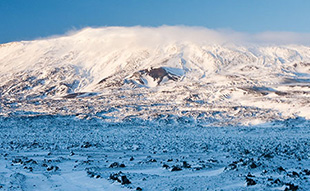Hekla is Iceland’s most famous volcano
An active volcano for centuries, the mountain Hekla is one of the most famous in the world. Hekla is a stratovolcano, located near the southern end of the eastern rift zone in Iceland.
The whole mountain ridge of Hekla is about 40 km long. The fissure, Heklugjá, which splits the ridge, is about 5.5 km long. The mountain is about 1, 491 m high. During historical times, frequent large explosive eruptions have deposited tephra throughout Iceland, which provide time markers used to date eruptions from other Icelandic volcanoes.
The legend of Hekla
Old tales tell of the belief that the souls of the condemned travelled through Hekla's crater on their way to Hell. Others say that the witches met with the devil on its top. It has been compared with Brocken and Vesuvius and the trio were thought to be the gateways down to Hell.
 Through the centuries, Hekla had achieved renown of almost mythical proportions – so much so, that when a German cartographer of the 16th century drew a new marine map of the Nordic countries, on the map of Iceland which he created, there was only one proper name: Hekl’berg (Hekla).
Through the centuries, Hekla had achieved renown of almost mythical proportions – so much so, that when a German cartographer of the 16th century drew a new marine map of the Nordic countries, on the map of Iceland which he created, there was only one proper name: Hekl’berg (Hekla).
Hekla’s notoriety continued through the next three centuries, the volcano appearing as a symbolic entity in the works of several European authors. The European name for Hekla was “Hekkenfeld”, the name that the great Icelandic Nobel Laureate Halldór Kiljan Laxness also used in his novel Iceland’s Bell (set at the close of the 17th century). When the novel´s protagonist Jón Hreggviðsson turns up in Holland, he quickly discovers that: “Everyone in Holland was familiar with Hekkenfeld in Iceland, under which burn the fires of Hell, and they were very eager to hear tales of this mountain. They called the man van Hekkenfeld.”
Hekla volcano - eruption history
It is thought that Hekla has had at least twenty eruptions since the settlement of Iceland in the year 874 AD. The biggest eruption was in 1104 AD when it erupted without warning ejecting millions of tonnes of tephra. It erupted four times in the 20th century, the last time in 2000. Hekla has erupted more often than any other volcano in Iceland. Some eruptions have been so powerful and violent that the volcanic ash reached as far as mainland Europe.
In the 1947 eruption, the last really big one, 14 m (46 ft) were added to its summit. In that eruption the volcano spewed up a column of ash as high as 28,000 metres into the atmosphere, and 51 hours after the eruption had started, volcanic ash from Hekla fell on Helsinki, having covered a distance of 2,860 km in this time.
Eruptions of Hekla are extremely varied and difficult to predict. Some are very short (a week to ten days) whereas others can stretch into months and years. The 1947 eruption that started on 29 March 1947 ended in April 1948. The quiet (or repose) period between Hekla's eruptions has ranged from 16 years to 121 years. A tendency toward longer repose intervals has occurred between the later eruptions.
Over the past 7000 years Hekla has had 5 big fissure eruptions. The biggest eruptions were 4000 and 2800 years ago. Traces of these two eruptions can be found in the soil in the north and the north-east of Iceland. The biggest layer of tephra from one eruption fell during the eruption 2800 years ago. It covers about 80% of the country and its volume was around 1.2 cubic km. Traces of it have been found in various places in Scandinavia. Over the last millennium, Hekla has produced one of the largest volumes of lava in the world, around 8 cubic km.
| Year |
Duration |
Lava & ash km3 |
Destruction caused |
| |
|
|
|
| 1104 |
unknown |
2,5 |
much |
| 1158 |
unknown |
0,15 |
some |
| 1206 |
unknown |
0,03 |
some |
| 1222 |
unknown |
0,01 |
little |
| 1300-01 |
12 months |
1,0 |
much |
| 1341 |
unknown |
0,08 |
much |
| 1389-90 |
unknown |
1.0 |
some |
| 1440 |
unknown |
unknown |
little |
| 1510 |
unknown |
0,32 |
some |
| 1554 |
unknown |
unknown |
little |
| 1597 |
6 months |
o,24 |
little |
| 1636 |
12 months |
0,08 |
little |
| 1693 |
7-12 months |
0,03 |
much |
| 1725 |
unknown |
unknown |
little |
| 1766-68 |
24 months |
1,7 |
some |
| 1845-46 |
7 months |
1,0 |
some |
| 1878 |
unknown |
unknown |
little |
| 1913 |
4-5 months |
unknown |
little |
| 1947-48 |
13 months |
1,0 |
some |
| 1970 |
2 months |
0,3 |
little |
| 1980-81 |
2 weeks |
0,25 |
some |
| 1991 |
2 months |
0,15 |
little |
| 2000 |
11 days |
0,11 |
little |